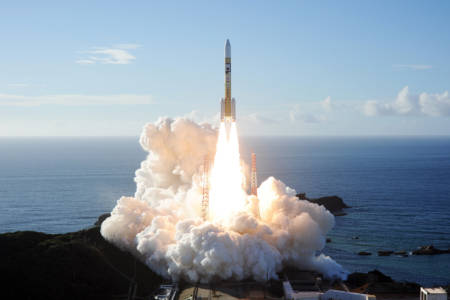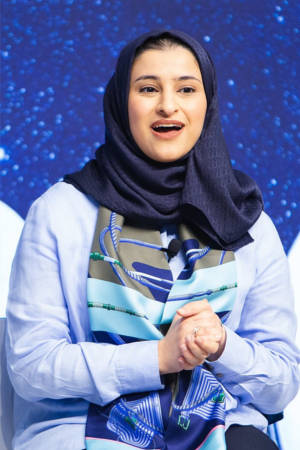Using AI to control energy for indoor agriculture
30 September 2024
Published online 25 July 2020
A UAE space mission promises the fullest yet picture of Mars’s atmosphere

MITSUBISHI HEAVY INDUSTRIES HANDOUT/EPA-EFE/Shutterstock
If successful, the mission will deeply enrich understanding of Mars’ atmosphere and climate.
The Emirates Mars Mission (EMM) is a strong statement, showcasing how far the young country has come in a few short decades. “It is a declaration of 50 years of work in the creation of a nation, a different way than how other nations were built,” says Sarah Al Amiri, deputy project manager of the mission, and minister of state for advanced sciences in the UAE.
Equally important, the government is signalling its commitment to shift from an economy dependent significantly on oil to one driven by knowledge-based products and services, Al Amiri says.
Such a shift would rely on a concerted effort to promote scientific research. Interplanetary exploration science became high on the country’s list, and a Mars mission would accelerate its space industry. “We found a nice gap” in Mars research that a UAE mission could plug and devote its mission to, Al Amiri says.
Once the decision settled on Mars, two linked questions arose. Who was to be the UAE’s partner on the Mars journey? And the answer to that would largely take care of the second question: what would mission’s scientific purpose be?
The EMM found a partner in the Colorado University’s Laboratory for Atmospheric and Space Physics (LASP). To begin with, “it had a record of success,” says James Murphy, professor of astronomy at New Mexico State University who served as external reviewer for the EMM between 2015 and 2017. The LASP team had won funding from NASA for the MAVEN Mars orbiter, launched in November 2013, and successfully operated it since. The orbiter studies Mars’s climate over very long periods of time and how it may have changed over time.
This was not the only CU team’s forte. The team had also mastered the synthesizing of data from various orbiter-mounted sensors to a degree not achieved before, Murphy says.
Those strengths were going to be channeled into the UAE Mars mission. “In determining the science thrust for EMM, we built on results from all of the missions that came before it, including MAVEN,” says Bruce Jakosky, associate director of science at LASP, and professor of geological sciences at Colorado University.
Through discussions with the Space Sciences Laboratory of the University of California at Berkeley, and Colorado’s LASP, it did not take long to determine that a better understanding of Mars’ lower atmosphere, and the coupling and energy transfer between lower and upper atmospheres, would serve as unique and significant objectives for the EMM.
While previous missions have looked at a “limited range” of the Mars atmosphere, the Hope probe “is going to do a very nice integration from the surface up to thousands of kilometers,” says Murphy.
The Hope spacecraft carries three instruments: the ultra-violet spectrometer, which will study the upper atmosphere; the Emirates Mars infrared spectrometer (EMIRS) and the high-resolution camera which will study the lower atmosphere. “For the first time a probe will provide a simultaneous view of the entire Mars atmosphere from surface to space,” says Philip Christensen, geophysicist at Arizona State University, which built the infrared spectrometer for Hope.
Though no instrument on Hope is novel, that does not detract from the mission’s scientific value. Essam Heggy, Mars scientist at the University of Southern California, notes that the Hope mission “intelligently uses existing scientific and engineering knowledge from previous missions to bring together a feasible and compelling space experiment.” Part of the appeal of this approach is that “it is the logical way to kickstart things” in a country launching its first space mission, he adds.

Flickr/ Wikimedia commons
Jakosky acknowledges the UAE’s timing of Hope’s arrival in orbit to mark the anniversary of the country’s creation. It shows “the country stepping up to the world stage as an equal participant” in global science pursuits, he says. “That is one of the mission’s unstated objectives.”
To accentuate its resolve to be a participant in the global Mars research, the Emiratis will make all the data from the probe’s sensors available to other researchers – not in real time, but after two months, which is a third of NASA’s waiting period before it releases data from its missions.
But should there be concern that the prestige factor associated with Mars may distract from science objectives? As long as “the science is good,” Jakosky replies, “the more missions the merrier, regardless of a country’s other incentives.”
And Arab space scientists, like Heggy of the University South California, find the UAE’s investment in this realm of knowledge heartening. “I can only appreciate that an Arab nation has picked such critical research questions and built a space program to address them,” he says.
“I know that many could be skeptical about the EMM experiment and the future of the programme,” he says, but “I truly believe the Hope mission will encourage more Arab countries to carry out audacious science initiatives.”
doi:10.1038/nmiddleeast.2020.79
Stay connected: